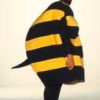Snapping shrimp, naked mole rats, ants, honeybees, and humans – what do they all have in common? They all share a similar colony-like organizational system that biologists have termed eusociality. Eusocial species have been remarkably successful in both surviving and thriving through the use of colony-level cooperation. One cooperative behavior used by all eusocial species […]







